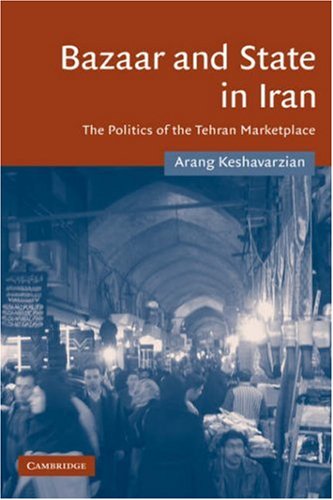Arang Keshavarzian0521866189, 9780521866187
Table of contents :
Cover……Page 1
Half-title……Page 3
Series-title……Page 4
Title……Page 5
Copyright……Page 6
Dedication……Page 7
Contents……Page 9
Maps……Page 10
Figures……Page 11
Acknowledgments……Page 12
Note on transliteration……Page 15
Map of Iran……Page 16
1 The puzzle of the Tehran Bazaar under the Pahlavi monarchy and the Islamic Republic……Page 17
Continuity, revolution, and state–society relations……Page 20
Studying transformative states……Page 26
What is beyond the state’s vision?……Page 29
What generates governance when a group is beyond the state’s vision?……Page 30
Variation in forms of governance……Page 32
The argument……Page 35
Networks as causal mechanisms……Page 39
Why the Tehran Bazaar?……Page 41
Temporality: synchronic and diachronic analysis……Page 42
Data collection……Page 45
Interviewing……Page 46
Participant Observation……Page 50
Primary and secondary texts……Page 53
2 Conceptualizing the bazaar……Page 55
A brief history of the Tehran Bazaar……Page 57
The bazaar as traditional type……Page 62
A note on cultural representations of the bazaar……Page 68
The Bazaar as a class……Page 72
The Bazaar as informal economy……Page 76
The Bazaar economy as a product of informational scarcity……Page 78
Beyond market and moral economy……Page 81
The Bazaar as networks……Page 86
Conclusions……Page 89
3 Bazaar transformations: networks, reputations, and solidarities……Page 90
Stable ties and roles within value chains……Page 93
Extending credit, relationships, and reputations across the Bazaar……Page 101
Crosscutting and multiplex social relationships……Page 107
Change in the Tehran Bazaar’s membership……Page 116
The consequences of fluid commercial relations and smuggling……Page 122
Heterogeneous social networks……Page 129
Acquisition and maintenance of reputation……Page 134
Reputation, inequality, and solidarity……Page 139
Conclusions……Page 141
4 Networks in the context of transformative agendas……Page 143
The Pahlavi regime and the Tehran Bazaar……Page 144
High modernism as a transformative program……Page 145
The replacing of traditional bazaars……Page 148
The Tehran Bazaar’s autonomy……Page 151
Economic policies and the Bazaar’s autonomy……Page 155
Spatial centralization and integration of the Bazaar’s networks……Page 157
The Islamic Republic and the Tehran Bazaar……Page 162
Islamic populism: the pragmatism of a revolutionary regime……Page 163
Patronage: the solution to the Islamic Republic’s Bazaar dilemma……Page 168
Repertoires of state incorporation……Page 173
Political incorporation……Page 177
Incorporation via regulation……Page 179
Incorporation via organizational competition……Page 182
The Bazaar’s response: eluding the institutional setting……Page 186
Delocalizing the Bazaar……Page 192
Urbanization and technological developments……Page 194
Delocalization through policies……Page 196
Conclusions……Page 201
5 Carpets, tea, and teacups: commodity types and sectoral trajectories……Page 203
The carpet bazaar……Page 204
Information acquisition via cooperative hierarchies……Page 206
Situating the carpet sector in Iran’s political economy……Page 211
Relations in the postrevolutionary carpet bazaar……Page 220
The tea bazaar……Page 222
Tea and the state……Page 224
Conclusions……Page 230
The china and glassware bazaar……Page 231
Comparisons and conclusions……Page 236
Group size……Page 237
Geographic dispersion of value chains……Page 238
Commodity type……Page 239
State regulation……Page 241
6 Networks of mobilization under two regimes……Page 244
Social movements and the mosque–bazaar alliance……Page 246
Bazaar mobilization with and without the clergy……Page 249
The tobacco protests (1890–2) and the Constitutional Revolution (1905–11)……Page 250
The Oil Nationalization Movement (1951–3)……Page 252
The anti-White Revolution protests (1963)……Page 254
The Islamic Revolution (1977–1979)……Page 256
Reflections on the mosque–bazaar alliance……Page 264
Transforming grievances and interests into mobilization……Page 271
Cooperative hierarchies as a foundation for collective action……Page 277
Coercive hierarchies as a source of quietism……Page 279
Conclusions……Page 284
7 Conclusions……Page 286
Insights from the Tehran Bazaar and the Iranian state……Page 290
Was the Islamic Revolution a social revolution?……Page 295
Selected bibliography……Page 299
Index……Page 314

Reviews
There are no reviews yet.